
Electrochemical Consumables
Double-Layer Water Bath Electrolytic Electrochemical Cell
Item Number : ELCWD
Price varies based on specs and customizations
$39.90 / set
- Specification
- 50ml ~ 500ml
- Applicable temperature range
- 0 ~ 60℃
- Material
- Boron glass + PTFE
Shipping:
Contact us to get shipping details Enjoy On-time Dispatch Guarantee.
Why Choose Us
Reliable PartnerEasy ordering process, quality products, and dedicated support for your business success.
The Temperature-controllable electrolytic cell features a double-layer water bath, excellent corrosion resistance, complete specifications, and customization options.
Technical specifications
Sealed double-layer water bath electrolytic cell
| Specification | 50ml ~ 250ml |
| Applicable temperature range | 0 ~ 60℃ |
| Sealed form | Thread + Apron |
| Material | Boron glass + PTFE |
| Electrolytic cell hole | Three electrode holes (6mm), two air holes (3mm), custom openings are available |
Unsealed open water bath electrolytic cell
| Specification | 50ml ~ 500ml |
| Applicable temperature range | 0 ~ 60℃ |
| Material | Boron glass + PTFE |
| Electrolytic cell hole | Three electrode holes (6mm), custom openings are available |
Detail & Parts


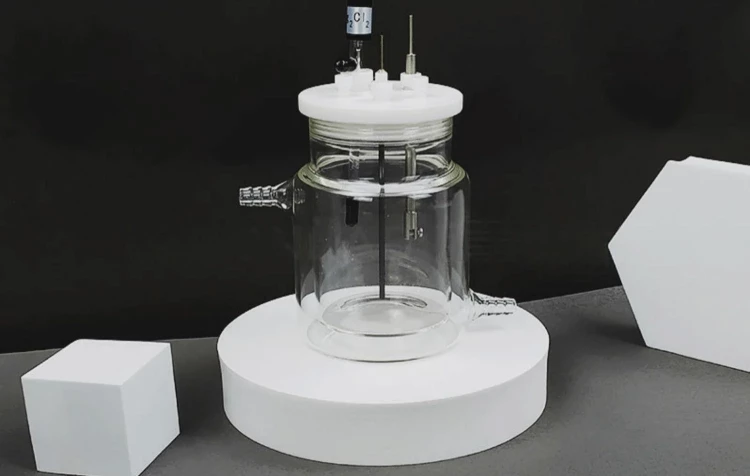
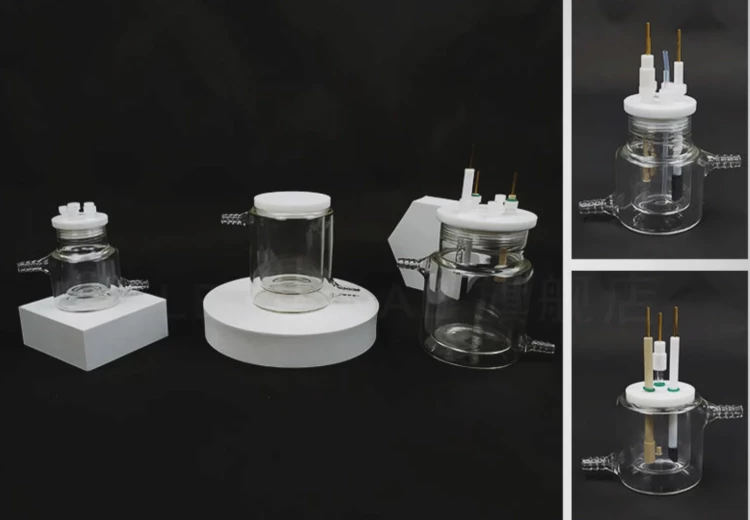
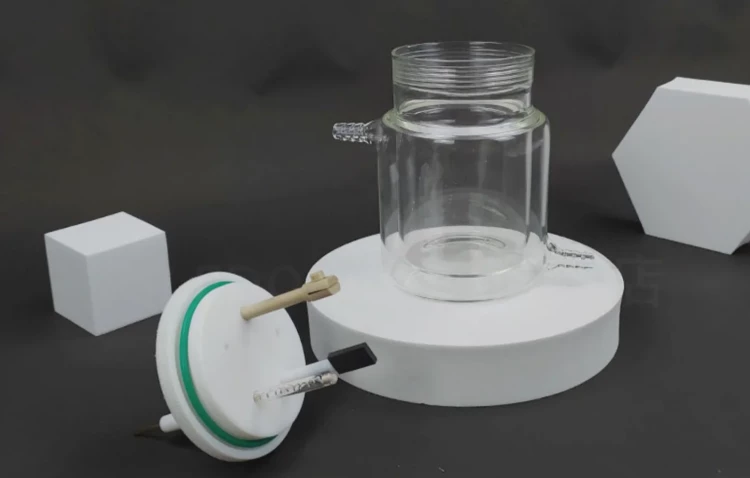

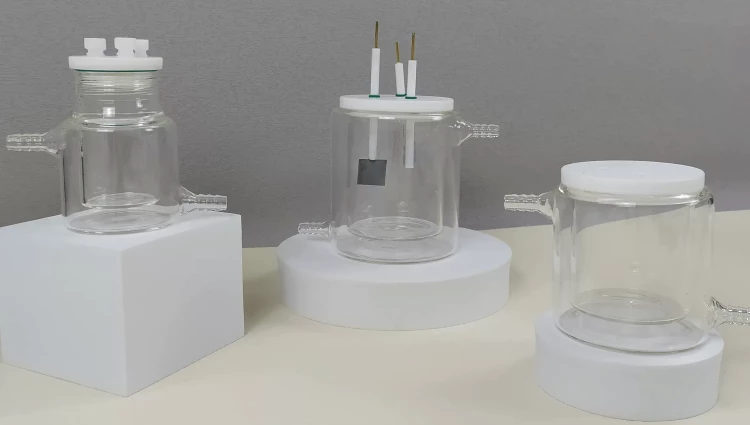
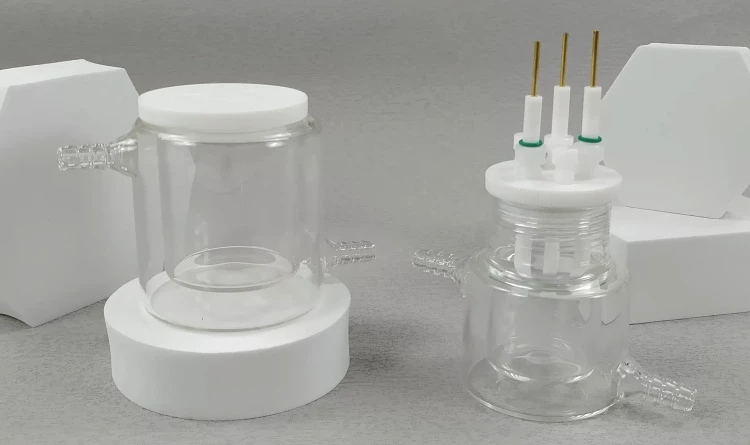
Operating steps
Sealed double-layer water bath electrolytic cell

1. The double-layer water bath electrolytic cell is composed of a sealing rubber ring, a sealing plug, a polytetrafluoroethylene cover and a cell body

2. When installing, insert the electrode and gas pipe into the electrolytic cell, and then install the sealing ring

3. Install the electrode and the sealing nut of the air hole on the electrode, squeeze the sealing ring and rotate the nut tightly.

4. Install the large sealing ring on the cell body, and completely clamp the sealing ring on the cover to ensure that the sealing ring is tightly locked.

5. The installation of the electrolytic cell is completed (the installation of the three-electrode system is completed)
Unsealed open water bath electrolytic cell

1. The non-sealed electrolytic cell consists of a fixed ring, a polytetrafluoroethylene cover and a cell body.

2. When installing, put the electrode on the rubber ring and place it on the cover.

3. The installation of the electrolytic cell is completed (the installation of the three-electrode system is completed).
Designed for You
KinTek provide deep custom made service and equipment to worldwide customers, our specialized teamwork and rich experienced engineers are capable to undertake the custom tailoring hardware and software equipment requirements, and help our customer to build up the exclusive and personalized equipment and solution!
Would you please drop your ideas to us, our engineers are ready for you now!
4.9
out of
5
The temperature-controllable electrolytic cell is a game-changer for our laboratory. The double-layer water bath ensures precise temperature control, and the customization options make it versatile for various applications.
4.8
out of
5
The sealed double-layer water bath electrolytic cell is a lifesaver! The excellent corrosion resistance and complete specifications make it a durable and reliable choice for our lab's research.
4.7
out of
5
The electrolytic cell's versatility is remarkable. From water electrolysis to electroplating, it handles a wide range of reactions efficiently. Definitely worth the investment!
4.8
out of
5
The unsealed open water bath electrolytic cell is a great value for money. Its simple design and easy installation make it a user-friendly option for our lab's needs.
4.9
out of
5
The technical specifications of the electrolytic cell are impressive. The applicable temperature range and customization options allow us to tailor it to our specific requirements.
4.7
out of
5
The double-layer water bath electrolytic cell's durability is unmatched. It has withstood rigorous use in our laboratory and continues to perform flawlessly.
4.8
out of
5
The electrolytic cell's technological advancement is commendable. Its ability to drive non-spontaneous redox reactions using electrical energy opens up new possibilities for our research.
4.9
out of
5
The speed of delivery for the electrolytic cell was exceptional. We received it within a week of placing the order, allowing us to start our experiments without delay.
REQUEST A QUOTE
Our professional team will reply to you within one business day. Please feel free to contact us!
Related Products

Double Layer Five-Port Water Bath Electrolytic Electrochemical Cell
Experience optimal performance with our Water Bath Electrolytic Cell. Our double-layer, five-port design boasts corrosion resistance and longevity. Customizable to fit your specific needs. View specs now.
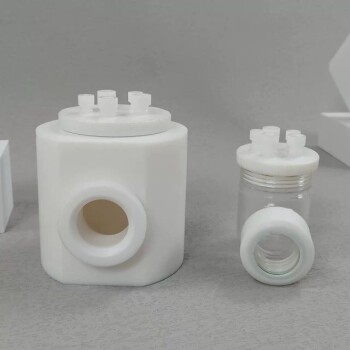
Side Window Optical Electrolytic Electrochemical Cell
Experience reliable and efficient electrochemical experiments with a side window optical electrolytic cell. Boasting corrosion resistance and complete specifications, this cell is customizable and built to last.

Thin-Layer Spectral Electrolysis Electrochemical Cell
Discover the benefits of our thin-layer spectral electrolysis cell. Corrosion-resistant, complete specifications, and customizable for your needs.

20L Chiller Water Bath Cooling Circulator Low Temperature Constant Temperature Reaction Bath
KinTek KCP chilling circulator is a versatile and reliable equipment that supplies constant chilling power with circulating fluids. It can work as a one chilling bath and reach a max. Chilling temperature of -120℃.

Glassy Carbon Electrochemical Electrode
Upgrade your experiments with our Glassy Carbon Electrode. Safe, durable, and customizable to fit your specific needs. Discover our complete models today.

Glassy Carbon Sheet RVC for Electrochemical Experiments
Discover our Glassy Carbon Sheet - RVC. Perfect for your experiments, this high-quality material will elevate your research to the next level.
Related Articles

The Architecture of Control: Why Thermal Stability Defines Electrolysis Success
Discover how double-layer water-bath electrolytic cells eliminate thermal variables, ensuring accuracy and reproducibility in electrochemical research.

The Glass Heart of the Experiment: Precision Through Systematic Care
Routine maintenance of double-layer electrolytic cells isn't just cleaning—it's calibration. Discover the systematic protocol for reproducible electrochemical data.

The Architecture of Precision: Mastering the Five-Port Water Bath Electrolytic Cell
Mastering the electrolytic cell is not just about chemistry; it is about discipline. Learn the systematic approach to preparation, operation, and maintenance.

Exploring the Multifunctional Electrolytic Cell Water Bath: Applications and Benefits
Discover the versatile applications of multifunctional electrolytic cell water baths in various industries. Learn about their benefits, components, and how they facilitate chemical reactions and temperature control.

The Transparency Paradox: Mastering the Fragile Art of Electrolytic Cells
Glass electrolytic cells are precision instruments, not simple containers. Learn the systematic approach to handling glass to ensure safety and data integrity.

The Silent Dialogue: Mastering Control in Electrolytic Cells
Electrolysis is a non-spontaneous act requiring precise control. Learn to interpret the interplay of voltage, current, and physical phenomena for safer lab results.

The Architecture of Precision: Why Your Electrolytic Cell Specs Matter More Than You Think
Discover the critical logic behind electrolytic cell specifications. From aperture geometry to volume trade-offs, learn how the right vessel defines experimental success.

The Glass Heart of the Experiment: Mastering the Electrolytic Cell
Master the art of handling electrolytic cells. Learn the critical balance between physical fragility, chemical safety, and operational precision.

The Architecture of Precision: Why the Invisible Details Define Electrochemical Success
Master the art of pre-use inspection for electrolytic cells. From physical integrity to electrode purity, learn why the invisible details dictate experimental safety.

The Invisible Architecture of Accuracy: Optimizing the Five-Port Electrolytic Cell
Master the critical pre-use protocols for five-port water bath electrolytic cells. Learn how meticulous preparation ensures reproducible electrochemical data.

Understanding Flat Corrosion Electrolytic Cells: Applications, Mechanisms, and Prevention Techniques
Explore the detailed workings of flat corrosion electrolytic cells, their role in industrial processes, and effective strategies to mitigate corrosion. Learn about electrolytic cells, their components, and applications in electroplating and metal purification.

The Unseen Variable: Mastering the Electrolytic Cell Inspection
Precision in electrochemistry begins before the current flows. Discover the critical pre-use checks for electrolytic cells that ensure safety and data integrity.